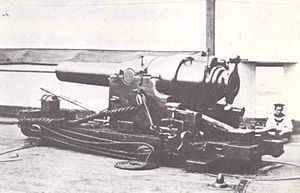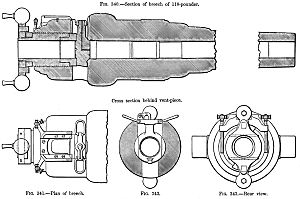RBL 7-inch Armstrong gun facts for kids
Quick facts for kids Ordnance RBL 7-inch gun |
|
|---|---|

A gun on a wooden slide carriage in the 19th century.
|
|
| Type | Naval gun Coast Defence gun |
| Place of origin | United Kingdom |
| Service history | |
| In service | 1861–190? |
| Used by | United Kingdom |
| Wars | New Zealand Wars Bombardment of Kagoshima Bombardment of Shimonoseki |
| Production history | |
| Designer | W.G. Armstrong Co. |
| Manufacturer | W.G. Armstrong Co. Royal Gun Factory |
| Unit cost | £425 - £650 (£47000-£72000 in 2013) |
| Produced | 1859–1864 |
| No. built | 959 |
| Variants | 82cwt, 72cwt |
| Specifications | |
| Barrel length | 99.5 inches (2.527 m) bore (14.21 calibres) |
|
|
|
| Shell | 90 to 109 pounds (40 to 50 kg) |
| Calibre | 7-inch (177.8 mm) |
| Breech | Armstrong screw with vertical sliding vent-piece (block) |
| Muzzle velocity | 1,100 feet per second (340 m/s) |
| Maximum firing range | 3,500 yards (3,200 m) |
The Armstrong RBL 7-inch gun was a powerful cannon from the 1800s. It was also known as the 110-pounder because of the weight of its shells. This gun was an early attempt to use a new way of loading cannons, called a rifled breechloading system. This system was invented by William Armstrong. Instead of loading from the front (muzzle), these guns loaded from the back (breech). This made them faster and safer to reload.
Contents
How the Gun Worked
The Armstrong gun had a special way of loading. It used a heavy metal block, called a "vent-piece," that slid into a slot at the back of the barrel. Behind this block was a large hollow screw.
To load the gun:
- The vent-piece was lifted up.
- The shell was pushed through the hollow screw and into the barrel.
- The powder cartridge (which made the gun fire) was also put in.
- The vent-piece was lowered back down.
- The large screw was tightened to hold everything in place.
- A small tube was put into the top of the vent-piece to fire the gun.
When the gun fired, the screw and vent-piece sealed the back of the gun. This stopped hot gases from escaping. The shells used with this gun had a thin lead coating. This coating was slightly bigger than the gun's barrel. As the shell moved, the lead coating gripped the spiral grooves inside the barrel. These grooves made the shell spin as it flew. Spinning shells flew farther and more accurately than older, non-spinning shells.
After each shot, a special "lubricator" was used. This was made of grease and oil. It followed the shell down the barrel. It cleaned out any lead left behind from the shell's coating. This kept the gun ready for the next shot.
History of the Gun
The idea of breech-loading guns had worked well for smaller cannons. So, the British government wanted to use it for bigger guns like the 7-inch gun. However, William Armstrong himself worried that his breech-loading system might not be strong enough for very heavy guns. He said that the "vent-piece" (the sliding block) was still a problem for the 100-pounder guns.
The first version of the gun weighed 72 cwt (about 8,064 pounds). But a heavier version, weighing 82 cwt (about 9,184 pounds), was made stronger. This heavier gun started being used by the navy in 1861. It was meant to replace older, less advanced cannons. The lighter 72 cwt version was later used on land starting in 1863.
Some experts in the British government studied different types of guns in 1862 and 1863. They decided that breech-loading systems were not good for "larger guns." They thought the 7-inch gun could not fire shells fast enough to damage the new armored warships of the time. One officer joked that the gun's shells would only harm wooden ships, not iron ones.
Another problem was that the vent-piece was very heavy (136 pounds). Gunners had to lift it out by hand to reload, which was hard during a battle. Also, the seal at the back of the gun depended on how tightly the gunners screwed it shut. If it wasn't tight enough, hot gases could escape.
Because of these issues, the production of the 110-pounder gun stopped in 1864. Britain went back to using heavy guns that loaded from the front (muzzle-loaders). The 7-inch guns that were already made were moved to fortresses. They stayed there for many years.
Even though the breech-loading design was stopped, the way Armstrong built the gun's barrel was still considered good. He used strong iron coils around an inner tube. This method was used for the next generation of muzzle-loading guns. Later, when Britain started using breech-loaders again around 1880, they used newer, better sealing systems that did not rely on how tightly a person screwed them.
The Gun in Action
The Royal Navy used the 7-inch gun in battles against land forts. This happened during the Bombardment of Kagoshima in 1863 and the Bombardment of Shimonoseki in 1864, both in Japan.
During the Bombardment of Kagoshima in August 1863, an officer on HMS Euryalus described a problem:
- "The breech piece of this gun blew out with tremendous effect, the concussion knocking down the whole gun's crew..." This happened because the gun was not handled correctly.
Another officer from the same ship said that the guns were good for long distances. But he also noted that the smoke was too much when used between decks. He mentioned that one vent-piece broke, but no one was hurt. He believed it was the gun captain's fault for not using a small metal cap correctly.
These stories show that while the guns could work well, they were difficult and potentially dangerous if not used perfectly during the stress of battle.
The gun was also used in the New Zealand Wars. On April 29, 1864, it was used to bombard Maori forts at Gate Pa. Even though the British fired many shells, the Maori defenders were safe in their bunkers. They managed to fight off the British attack, causing many losses for the British.
Ammunition
Where to See Them Today
You can still see some of these old Armstrong 7-inch guns in different places:
- An 82cwt gun at Victoria Barracks, Sydney, Australia.
- An 82cwt gun at Saint Helier, Jersey.
- A 72cwt gun at Fort Nelson, Portsmouth, UK. This one has a copy of its original breech and carriage.
- At Fort Henry, Ontario, Canada.
- A 72 cwt gun at Quebec Citadel, Canada.
- A 72 cwt gun at Fort No. 1, Lévis, Quebec, Canada.
See also
- Armstrong Gun
- List of naval guns







